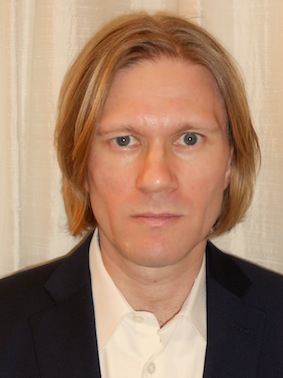 Mark Haskins is Professor of Mathematics at Duke University. He is the Deputy Collaboration Director for the Collaboration and a member of the Collaboration’s Scientific Steering Committee. In his capacity as Deputy Collaboration Director he has overseen the organization (both scientific and logistical) of many of the Collaboration’s regular Collaboration meetings.
Mark Haskins is Professor of Mathematics at Duke University. He is the Deputy Collaboration Director for the Collaboration and a member of the Collaboration’s Scientific Steering Committee. In his capacity as Deputy Collaboration Director he has overseen the organization (both scientific and logistical) of many of the Collaboration’s regular Collaboration meetings.
He received his PhD in Mathematics in 2000 from the University of Texas at Austin under the supervision of Abel Prize winner Karen Uhlenbeck. He was a JJ Sylvester Assistant Professor at Johns Hopkins University and a Hodge Fellow at Institut des Hautes Études Scientifiques, before joining Imperial College London in 2004, initially as a postdoctoral researcher working with Sir Simon Donaldson FRS. Haskins remained at Imperial until 2017 having been promoted to Full Professor in 2013; for many years he was the organizer of the internationally-known weekly London Geometry and Topology seminar. In 2017 he moved to the University of Bath to take up a Chair in Analysis. Haskins joined Duke as Full Professor in summer 2019.
He held an EPSRC Leadership Fellowship from 2009-2013 and an EPSRC Developing Leaders award from 2013-2015. In 2014 he was elected a Fellow of the Learned Society of Wales. He has given more than 175 invited talks and lectures at top international mathematics conferences and seminars in the leading mathematics departments around the world. He is currently one of the two Managing Editors of the Journal of the London Mathematical Society.
His research is in differential geometry and geometric analysis. He has made important contributions to the areas of calibrated geometry and special and exceptional holonomy metrics, including the construction of many new singular special Lagrangian ![]() -folds, the construction of a very large number of new families of compact 7-manifolds with holonomy
-folds, the construction of a very large number of new families of compact 7-manifolds with holonomy ![]() and the construction of many compact rigid associative submanifolds in compact 7-manifolds with holonomy
and the construction of many compact rigid associative submanifolds in compact 7-manifolds with holonomy ![]() . In 2017 Haskins and former student Foscolo discovered the first examples of complete inhomogenous nearly Kähler 6-manifolds, solving an outstanding problem dating back to the late 1960s. He has supervised a number of successful PhD students and postdoctoral researchers who have gone on to establish themselves as leading members of the younger generation of researchers in the field.
. In 2017 Haskins and former student Foscolo discovered the first examples of complete inhomogenous nearly Kähler 6-manifolds, solving an outstanding problem dating back to the late 1960s. He has supervised a number of successful PhD students and postdoctoral researchers who have gone on to establish themselves as leading members of the younger generation of researchers in the field.
His recent focus has been on understanding 7-manifolds with holonomy ![]() that are highly collapsed and more specifically those that are Gromov—Hausdorff close to a 6-dimensional Calabi—Yau space. This limiting regime of
that are highly collapsed and more specifically those that are Gromov—Hausdorff close to a 6-dimensional Calabi—Yau space. This limiting regime of ![]() holonomy metrics is intimately connected with the limit in which M-theory compactified on a
holonomy metrics is intimately connected with the limit in which M-theory compactified on a ![]() holonomy space is well-approximated by Type IIA String Theory compactified on a 6-dimensional Calabi—Yau space with fluxes, branes and orientifolds. The work of Haskins and his collaborators Foscolo and Nordstr\”om in this direction has already transformed the landscape of known complete noncompact
holonomy space is well-approximated by Type IIA String Theory compactified on a 6-dimensional Calabi—Yau space with fluxes, branes and orientifolds. The work of Haskins and his collaborators Foscolo and Nordstr\”om in this direction has already transformed the landscape of known complete noncompact ![]() holonomy spaces: from a few existing highly symmetric families of examples with limited topology to the realization of infinitely many topological types, the construction of large parameter families of such spaces and examples with only a 1-dimensional symmetry group.
holonomy spaces: from a few existing highly symmetric families of examples with limited topology to the realization of infinitely many topological types, the construction of large parameter families of such spaces and examples with only a 1-dimensional symmetry group.
In ongoing work with these collaborators he is extending this method to deal with compact highly collapsed ![]() holonomy spaces— where further global constraints significantly complicate matters. Compact singular
holonomy spaces— where further global constraints significantly complicate matters. Compact singular ![]() holonomy spaces are a necessary ingredient for M theory compactifications to yield realistic physical field theories in their low energy limits. However, currently there are no mathematical constructions of compact singular
holonomy spaces are a necessary ingredient for M theory compactifications to yield realistic physical field theories in their low energy limits. However, currently there are no mathematical constructions of compact singular ![]() holonomy spaces with the sort of codimension 7 singularities required to support chiral matter in the resulting 4-dimensional field theories. Therefore one particular focus is the use of their methods to construct the first examples of compact singular
holonomy spaces with the sort of codimension 7 singularities required to support chiral matter in the resulting 4-dimensional field theories. Therefore one particular focus is the use of their methods to construct the first examples of compact singular ![]() holonomy spaces with singularities modeled on
holonomy spaces with singularities modeled on ![]() holonomy cones.
holonomy cones.